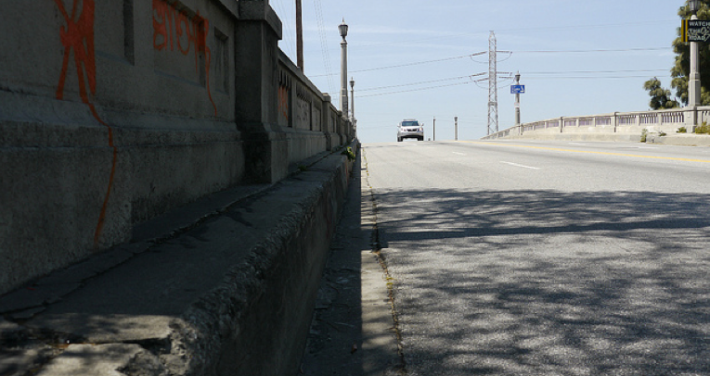
(Yesterday, a new advertisement appeared in our sidebar advertising a public meeting on the North Spring Street Bridge Improvement project on Tuesday, May 10, at 6:00 P.M. at the Lincoln Heights Senior Citizen Center at 2323 Workman Avenue. Below is a summary of the project, most of which was written before the advertisement was placed. - DN)
The North Spring Street Bridge Replacement/Improvement project has been a controversial one for the four years its been under debate. The City and Caltrans claim the bridge is in poor structural health and has car travel lanes that are too narrow. Historic preservationists claim that the bridge has local historical significance transportation reformers claim that plans to replace or improve the bridge will increase the amount of cars flowing in to the area.
Last year, the city attempted a rushed process to push through a plan to expand the traversable width of the bridge from 50 feet to 90 feet. Only a surprise vote by the City Council Transportation Committee prevented the bridge from being widened to nearly double its current size "to make room for cyclists and pedestrians." This week, the city and Caltrans announced a new public hearing to vet two possible designs to expand the bridge.
The first design proposed design widens the south side of the bridge, restripe the lanes to include a bike lane in each direction, widen the sidewalk on the north side of the bridge and add a sidewalk to the south side. The second design spreads the widening out but has the same basic impact. The bridge will still have four mixed travel lanes, two new bike lanes, and sidewalks on both sides of the bridge.
Even though neither plan would add a mixed-use travel lane, the bridge will be able to accommodate more automobile traffic after the widening. Currently travel lanes on the bridge are 9.5 feet wide. After the widening, the lanes will swell to eleven feet, wide enough to accommodate much faster, and higher volumes of traffic.
The coalition of historic preservation groups that managed to stall the project last year has yet to weigh in on either of the designs, but during past rounds of public input they have pushed for construction of a second bridge for cyclists and pedestrians to preserve the current bridge without any widenings. A second bridge wouldn't just be more efficient and safer for cyclists and pedestrians, it wouldn't "ruin" the current bridge's design or character. The L.A. Conservancy provides excellent background on the project in addition to explaining their position.
Yesterday, the Los Angeles County Bicycle Coalition weighed in on the plan at their blog. While they were happy to see improved connections for active transportation, they also questioned the value of the connection without existing bicycle infrastructure on either side of the bridge.
It is crucial, however, that these facilities continue along Spring Street; a bike lane that only lasts the length of the bridge is only minimally beneficial. LACBC will continue to push for connectivity beyond the bridge at BPIT meetings.
The LACBC has written a letter that could serve as a template for those wishing to weigh in on the bridge. In addition to bicycle connectivity, widened mixed-use lanes, and the cultural significance of the bridge, their letter can be read here.
According to the Conservancy, "Construction on the North Spring Street Viaduct began in 1927, seventeen years after the completion of the adjacent North Main Street Bridge (HCM #901) and North Broadway Bridge (HCM #907).
Designed by John C. Shaw, the crossing was built to relieve traffic along the North Broadway Bridge. Its design was intended to complement the classical motif of these two earlier works, linking the three spans as a thematic sub-group that connects Lincoln Heights to downtown Los Angeles."







